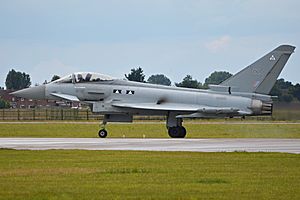No. 2 Squadron RAF facts for kids
Quick facts for kids No. II (AC) Squadron RAF |
|
|---|---|

Squadron badge
|
|
| Active | 13 May 1912 – 1 April 1918 (RFC) 1 April 1918 – 20 January 1920 (RAF) 1 February 1920 – 9 January 2015 12 January 2015 – present |
| Country | |
| Branch | |
| Type | Flying squadron |
| Role | Multi–role combat |
| Part of | No. 1 Group RAF |
| Home station | RAF Lossiemouth |
| Nickname(s) | 'Shiny Two' |
| Motto(s) | Hereward – Guardian of the Army |
| Aircraft | Eurofighter Typhoon FGR4 |
| Battle honours |
|
| Commanders | |
| Current commander |
Wing Commander E E Rickards |
| Notable commanders |
Jock Stirrup, Philip Sturley, Chris Nickols, Richard Garwood, Stephen Hillier |
| Insignia | |
| Squadron tail badge | 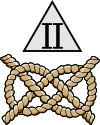 |
| Squadron badge heraldry | The RAF roundel (three concentric circles) over all a wake knot. Approved by King Edward VIII in May 1936. The circles represent the RAF and the wake knot is derived from the arms of Hereward the Wake and indicates the basic role of the unit as a guardian of the Army. |
| Post 1950 squadron roundel |  |
| Squadron Codes | KO (Nov 1939–May 1941) XV (May 1941–1943) OI (Sep 1946–Apr 1951) B (Apr 1951–1955) A–Z (Tornados) |
Number 2 Squadron, also known as No. II (Army Co-operation) Squadron, is the oldest flying squadron in the Royal Air Force (RAF). It is currently based at RAF Lossiemouth in Moray, Scotland. The squadron uses Eurofighter Typhoon FGR4 jets.
The "AC" in its name stands for "Army Co-operation." This means the squadron traditionally works closely with the army. Its motto, Hereward (Guardian of the Army), and its crest with a special knot, also show this connection. People sometimes call it Shiny Two.
Contents
History of No. 2 Squadron
Early Days and World War I
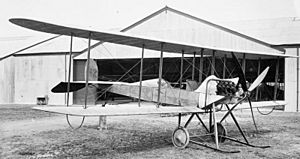
No. 2 Squadron was created on May 13, 1912, in Farnborough, England. It was one of the very first squadrons of the new Royal Flying Corps (RFC). This was a new air force branch of the British Army. The squadron used different types of early aircraft, including the Royal Aircraft Factory B.E.2.
In 1913, the squadron moved to RAF Montrose in Scotland. This became the first active RFC base in the UK. When World War I began, No. 2 Squadron was the first to fly across the English Channel into France. They spent the war doing important reconnaissance (scouting) missions over France. They mostly flew the B.E.2 aircraft.
Even though their main job wasn't fighting other planes, some of their pilots were very brave. Two pilots from the squadron, Rhodes-Moorhouse and Alan Arnett McLeod, were awarded the Victoria Cross. This is the highest award for bravery in the British military.
Between the World Wars
After World War I, the squadron added "AC" to its name, meaning "Army Co-operation." This showed their role in helping the army. In the early 1920s, they flew missions during the partition of Ireland. They also spent some time in China in 1927. Later, they used Armstrong Whitworth Atlas aircraft for their army support work.
No. 2 Squadron in World War II
When Second World War started, No. 2 Squadron was flying Westland Lysander aircraft. They were in France until the Dunkirk evacuation. After that, they were based in England.
Over time, the squadron started using faster fighter planes. They flew the Curtiss Tomahawk in 1941 and the North American Mustang in 1942. In 1944, they returned to France to continue their reconnaissance role. They later switched to Supermarine Spitfire Mk.XIVs. After the war ended in Europe, Shiny Two moved to Germany as part of the British forces there.
Cold War Operations (1945–1988)
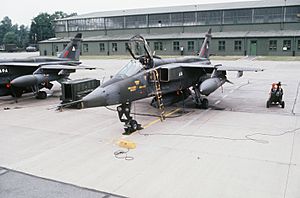
During the Cold War, No. 2 Squadron spent many years in West Germany. They flew various fighter and reconnaissance aircraft, such as the Supermarine Swift FR.5 and Hawker Hunter FR.10. In 1970, they started using the McDonnell Douglas Phantom FGR.2.
Later, in 1976, the squadron began to switch to the SEPECAT Jaguar GR1. These jets were faster and more modern. They continued to fly the Jaguar until 1988.
The Tornado Years (1988–2015)
In 1988, No. II (AC) Squadron started flying the Panavia Tornado GR1. Some of their planes were sent to the 1991 Gulf War. After the Gulf War, the squadron moved back to the UK, to RAF Marham in Norfolk. Their Tornados were updated to the GR4 version.
The squadron used these Tornado GR4s in Iraq during Operation Telic in 2003. They also took part in missions over Libya during Operation Ellamy in 2011. For these operations, they received special "battle honours" for their bravery.
In 2012, a memorial was built for No. 2 Squadron at the National Memorial Arboretum in England. It honors everyone who served in the squadron. In 2014, the squadron's Tornados helped search for kidnapped schoolgirls in Nigeria as part of Operation Turus.
Eurofighter Typhoon Era (2015–Present)
In 2013, it was announced that No. 2 Squadron would stop flying Tornados and start using Eurofighter Typhoon jets. This change happened on January 12, 2015, when the squadron moved to RAF Lossiemouth in Scotland.
In 2016, four of the squadron's Typhoons went to the Far East. They took part in training exercises with Japan and South Korea. This was the first time these countries had hosted exercises with a foreign air force other than the United States.
On July 26, 2019, the squadron was given the "Freedom of Angus." This special honor marked 106 years since they were first based at Montrose Air Station in Angus. A parade was held, and the squadron's Typhoons flew overhead.
Aircraft Operated by No. 2 Squadron
- Bristol Boxkite (1912)
- Breguet G.3 biplane (1912)
- Royal Aircraft Factory B.E.1 (1912)
- Farman S.7 Longhorn (1912)
- Royal Aircraft Factory B.E.2 (1912)
- Henry Farman Biplane (1912)
- Royal Aircraft Factory B.E.2a (1912)
- Farman S.11 Shorthorn (1914)
- Royal Aircraft Factory R.E.1 (1914)
- Royal Aircraft Factory B.E.2c (1914)
- Royal Aircraft Factory R.E.5 (1914)
- Vickers FB.5 (1915)
- Royal Aircraft Factory B.E.2b (1915)
- Bristol Scout (1915)
- Royal Aircraft Factory B.E.2d (1916)
- Royal Aircraft Factory B.E.2e (1917)
- Armstrong Whitworth F.K.8 (1917)
- Bristol F.2b Fighter (1920)
- Armstrong Whitworth Atlas (1929)
- Hawker Audax (1933)
- Hawker Hector (1937)
- Westland Lysander I (1938)
- Westland Lysander II (1940)
- Westland Lysander III (1940)
- Curtiss Tomahawk I (1941)
- Curtiss Tomahawk II (1941)
- North American Mustang I (1942)
- North American Mustang IA (1944)
- North American Mustang II (1944)
- Vickers-Supermarine Spitfire XIV (1944)
- Vickers-Supermarine Spitfire XI (1945)
- Vickers-Supermarine Spitfire PR.19 (1946)
- Gloster Meteor FR.9 (1950–1951)
- Gloster Meteor PR.10 (1951–1956)
- Supermarine Swift FR.5 (1956–1960)
- Hawker Hunter FR.10 (1960–1971)
- McDonnell Douglas Phantom FGR.2 (1970–1976)
- SEPECAT Jaguar GR1 (1976–1988)
- Panavia Tornado GR1A (1988–2001)
- Panavia Tornado GR4A (2001–2015)
- Eurofighter Typhoon FGR4 (2015 – present)
Battle Honours
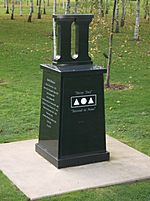
No. 2 Squadron has earned many "battle honours" for its service in different conflicts. These honors recognize the squadron's important role in major battles and campaigns. The ones in bold can be displayed on the squadron's official flag.
- Western Front 1914–1918
- Mons
- Neuve Chapelle
- Loos
- Somme 1916
- Arras
- Somme 1918
- Lys
- France and Low Countries 1939–1940
- Dunkirk
- Fortress Europe 1941–1944
- Normandy 1944
- Arnhem
- Walchern
- Rhine
- France and Germany 1944–1945
- Gulf 1991
- Iraq 2003
- Libya 2011
Special Achievements
- Second Lieutenant William Rhodes-Moorhouse from No. 2 Squadron was the first British airman to receive the Victoria Cross. He earned it during a raid in Belgium on April 26, 1915.
- No. 2 Squadron was the first RFC squadron to fly across the English Channel to France at the start of World War I.
Images for kids
-
Two No. 2 Squadron North American Mustang I in 1942.
-
Hawker Hunter T.7 WV372 in No. II (AC) Squadron markings, 2012. (This jet was operated by the unit during the 1960s up until 1971.)
-
Panavia Tornado GR1A in camouflage colour scheme and No. 2 Squadron markings during 1990.
-
Panavia Tornado GR4 in grey colour scheme and special markings for the 95th anniversary of the squadron in 2007.
See also
- List of Royal Air Force aircraft squadrons
- Montrose Air Station Heritage Centre


